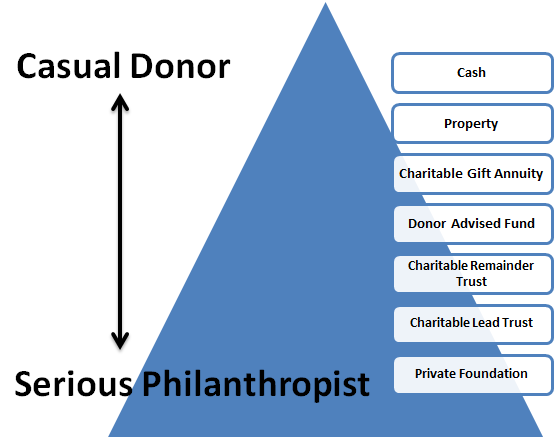Brave New World of Itemized Deductions
I’m on kind of a “Pease limitation” kick this week. In my earlier blog post I railed about the limitation which basically scales back the itemized deductions of high income taxpayers by 3% of any excess adjusted gross income (AGI) over certain levels. Essentially, once you reach the magic AGI number ($250,000 for singles, $300,000 for married filing jointly), your itemized deductions, including the deduction for charitable contributions, are dialed back by 3% of the excess income over that threshold amount. (Example – a single individual with $375,000 of AGI would lose up to $3,750 of itemized deductions: $375,000 – $250,000 = $125,000 x 3% = $3,750). This limitation has an effective overall limitation to it – you cannot lose more than 80% of your total deductions.
I know what some of you are thinking – why should I feel sorry for the fat cats? But I am not asking you to feel sorry for these folks – I am asking you to consider fairness and transparency in our tax system, both of which are in seriously short supply these days up and down the spectrum of the tax law.
The “Pease limitation” is a perfect example. Through the careful use of smoke and mirrors, it can effectively add up to 1.2% to the ordinary tax rate. Think of it this way – a top bracket taxpayer who is subject to the “Pease limitation” earns an additional $1,000. His itemized deductions will be reduced by 3% of that $1,000, or $30. This reduction in deductions is essentially an increase in income – his increase in overall taxable income will be $1,030. Multiply that additional taxable income by 39.6% to get the additional tax of $408. $408 divided by $1,000 is equal to 40.8%, which is 1.2% higher than the stated top rate of 39.6%.
But wait, there’s more!….
- Combine this haircut along with the Obamacare tax on “excess” earnings of .9% and the top rate is further increased to 41.7% for earned income. In our example, the marginal tax would be $417 instead of $408;
- If the marginally generated income is actually net investment income rather than earnings, the situation is worse – the top tax rate on investment income rises to 44.6%, or $446 in our example;
- And we haven’t even touched the phaseout of personal exemptions or the alternative minimum tax (AMT) yet!
So I guess that’s it – Phil Mickelson’s possible decision to stop making millions playing golf seems rational under these circumstances, correct? If you’re gonna take what I earn, I may as well not earn it. Well, I think that’s a bit extreme. Let’s put it into some perspective.
The “Pease limitation” comes into play ONLY with INCREASES IN INCOME. It has nothing to do with increases in deductions. So the argument that charitable contributions will suffer because of the limitation itself is misguided. Think of it this way – if income is held constant, each and every dollar of allowable charitable contribution will reduce taxable income by one dollar. If my income is $X and I am in the 39.6% tax bracket and I decide to make a $10,000 to the Human Fund on December 31, 2013, I will save $3,960 in federal income tax. Period. Assuming that my charitable contributions are not constrained by the income limitation rules that have long existed for these deductions, I don’t lose ANY value of the additional deduction because of an increase in deductions. However, if my income increases, I absolutely will lose the benefit of some of my deductions because of the “Pease limitation.” The decision to increase or decrease charitable contributions or any other deductible expenses can and should be made independently of the decision to increase or decrease taxable income.
The bottom line is that additional deductions will always do you some good in saving taxes while additional income may end up being taxed at a rate higher than you would like. Decisions about one versus the other should be made independently of one another.


